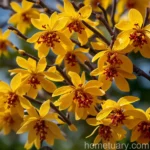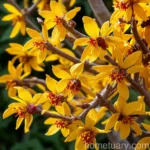Witch Hazel (Hamamelis x intermedia ‘Aurora’): A Complete Guide to Plant Care
Witch hazel, scientifically known as Hamamelis x intermedia ‘Aurora’, is a remarkable plant celebrated for its vibrant and fragrant flowers. This distinctive shrub has gained popularity for its cultural significance, medicinal uses, and its role in landscaping. In this comprehensive guide, we will delve into the various aspects of witch hazel, including its care, uses, propagation, common diseases, and more.
What is Witch Hazel (Hamamelis x intermedia ‘Aurora’)?
Hamamelis x intermedia ‘Aurora’ is a highly-valued cultivar of the Hamamelis genus. It is a cross between Hamamelis japonica and Hamamelis mollis, resulting in a hardy and beautiful shrub with rich, aromatic blossoms. The ‘Aurora’ variety is particularly renowned for its golden-yellow flowers with a sweet fragrance, making it a popular choice for landscape design and ornamental gardening.
One of the most fascinating characteristics of witch hazel is its flowering time, which usually occurs in late winter to early spring when most other plants are dormant. This distinctive feature lends an enchanting quality to the winter garden and provides much-needed color and fragrance during the colder months.
Key Takeaways – Witch Hazel (Hamamelis x intermedia ‘Aurora’)
Before we delve into the specifics of witch hazel care, uses, and other aspects, let’s take a moment to highlight the key takeaways of this remarkable plant.
- Botanical Name: Hamamelis x intermedia ‘Aurora’
- Common Name: Witch Hazel
- Type: Deciduous shrub
- Flower Color: Golden-yellow
- Flowering Time: Late winter to early spring
- Fragrance: Sweet and aromatic
- Uses: Medicinal, ornamental, landscaping
- Hardiness Zones: 5-8
- Growth Rate: Slow to moderate
- Size: 10-15 feet in height and spread
- Special Features: Unique winter flowering, beautiful fall foliage
Now, let’s explore the various aspects of caring for this captivating shrub.
Culture
Cultivating witch hazel successfully involves understanding its specific cultural requirements, including those related to water, sunlight, soil, and fertilizer. Let’s delve into each of these aspects to ensure the optimal growth and health of your witch hazel plant.
Water
Proper watering is essential for the health and vitality of witch hazel. While this shrub is relatively drought-tolerant once established, it thrives with regular moisture, especially during the drier months. When watering your witch hazel:
- Established Plants: Provide 1-2 inches of water per week during the growing season, especially during prolonged dry spells.
- Newly Planted Shrubs: Ensure consistent moisture for the first year after planting to support root establishment.
- Avoid Waterlogging: Witch hazel prefers well-drained soil, so it’s crucial to prevent waterlogging, which can lead to root rot.
Sunlight
Witch hazel exhibits exceptional adaptability to different light conditions, making it suitable for a range of garden settings. Understanding its sunlight requirements is vital for ensuring robust growth and prolific flowering:
- Full Sun: While witch hazel can tolerate full sun, especially in cooler climates, it generally prefers partial shade, especially during the hottest part of the day.
- Partial Shade: Providing dappled sunlight or partial shade is ideal for most growing regions, helping to protect the plant from harsh midday sun.
Fertilizer
Feeding witch hazel with the right nutrients can enhance its overall health, promote flowering, and encourage vibrant foliage. Consider the following when fertilizing your witch hazel:
- Timing: Apply a balanced, slow-release fertilizer in early spring before new growth emerges.
- Avoid Over-fertilization: Witch hazel is not excessively demanding in terms of fertilization. Overfeeding can lead to excessive foliage at the expense of blossoms, so moderation is key.
Soil
Understanding your soil type and making necessary amendments can significantly impact the well-being of your witch hazel plant. Consider the following soil-related factors:
- Acidic Soil: Witch hazel thrives in slightly acidic to neutral soil (pH 5.5-7.5). Amending excessively alkaline soil with organic matter such as peat moss or well-rotted compost can help create the ideal growing conditions.
- Well-Drained Soil: Ensuring good drainage is crucial. Witch hazel does not tolerate waterlogged soil, which can lead to root rot and other issues.
Pruning
Pruning plays a vital role in maintaining the health, shape, and flowering potential of your witch hazel. Proper pruning involves the removal of dead or diseased wood, shaping the plant, and encouraging a robust framework for future growth. It’s essential to consider the following when pruning your witch hazel:
- Timing: Prune witch hazel immediately after flowering, typically in late spring or early summer. This allows the plant to develop new growth and flower buds for the following season.
- Deadheading Flowers: Removing spent flowers not only enhances the plant’s appearance but also encourages better flowering in subsequent years.
Propagation
Propagation allows you to expand your witch hazel collection or share the beauty of this plant with others. While witch hazel can be propagated from seeds, it’s important to note that the resulting plants may not resemble the parent shrub. Instead, consider the following propagation methods:
- Softwood Cuttings: Propagate witch hazel from softwood cuttings taken in early summer. Use a rooting hormone to encourage successful root development.
- Layering: Air layering is another effective method for propagating witch hazel, particularly for mature shrubs.
Container Popularity
The versatility of witch hazel makes it an excellent candidate for container gardening. Its ornamental value, fragrance, and unique blooming time make it a sought-after choice for those seeking to adorn patios, decks, or small garden spaces with captivating plant specimens.
When growing witch hazel in containers, consider the following factors:
- Container Size: Choose a large, sturdy container to accommodate the mature size of the shrub and provide ample room for root growth.
- Well-Draining Soil: Use a high-quality potting mix that promotes good drainage to prevent waterlogging.
- Watering: Containers may require more frequent watering, especially during the hot, dry months.
Common Diseases
While witch hazel is generally resilient, it can fall victim to certain diseases that may affect its growth and appearance. Understanding these common diseases is essential for early detection and effective management.
Disease Diagnosis
When caring for your witch hazel, watch out for the following common diseases:
- Leaf Spot: Characterized by dark spots on the leaves, often caused by fungal pathogens. Ensure good air circulation and avoid watering the foliage to prevent this disease.
- Powdery Mildew: This fungal disease appears as a powdery white coating on the leaves, often in humid conditions. Apply fungicidal treatments as needed to manage the issue.
Common Pests
Witch hazel can attract certain pests that may compromise its health and appearance. Vigilance and timely intervention can help mitigate the impact of these pests.
- Aphids: These small, sap-sucking insects can congregate on the young shoots and undersides of the leaves. Use insecticidal soap or neem oil to control aphid infestations.
- Japanese Beetles: These voracious pests can cause significant damage to foliage and flowers. Consider using physical barriers or traps to manage Japanese beetle populations.
Botanist’s Tips
As a plant enthusiast and gardener, here are some valuable tips to help you maximize the potential of your witch hazel plants:
- Mulching: Apply a layer of organic mulch around the base of your witch hazel to conserve soil moisture, regulate soil temperature, and suppress weed growth.
- Companion Planting: Pair witch hazel with compatible companion plants such as early spring bulbs, hellebores, or other shade-loving perennials to create visually appealing and ecologically beneficial garden spaces.
- Regular Monitoring: Keep a close eye on your witch hazel plants, observing for any signs of stress, disease, or pest infestations. Early intervention is often key to successful management.
Fun Facts
Witch hazel is as intriguing as it is beautiful. Here are some fascinating and lesser-known facts about this enchanting shrub:
- Medicinal Uses: Witch hazel has been traditionally used for its astringent and anti-inflammatory properties, making it a popular ingredient in skincare and medicinal preparations.
- Winter Fragrance: The sweet, spicy fragrance of witch hazel flowers can perfume the air, adding a delightful sensory experience to the winter garden.
- Wildlife Attraction: Witch hazel flowers provide an important nectar source for early-emerging pollinators such as bees and butterflies, contributing to ecological diversity.
Links to External Resources
For further information on witch hazel plant care, medicinal uses, and landscaping possibilities, consider exploring the following external resources:
- Royal Horticultural Society – Hamamelis
- University of Maryland Medical Center – Witch Hazel
- The American Phytopathological Society – Witch Hazel Diseases
In conclusion, cultivating Hamamelis x intermedia ‘Aurora’ – Witch Hazel is a rewarding experience that offers a sensory delight to the gardener and a visual spectacle for all who encounter its vibrant blooms. By understanding its cultural needs, utilizing proper care techniques, and appreciating its multifaceted beauty, you can create a thriving and visually stunning display of this unique and captivating shrub.
Remember to observe and nurture your witch hazel plants, embracing their ephemeral winter blooms, and celebrating their rich botanical heritage. Whether you’re drawn to its ornamental appeal, medicinal uses, or ecological significance, witch hazel undoubtedly holds a special place in the realm of horticulture, enriching our landscapes and touching our lives in diverse and remarkable ways.
Happy gardening!















